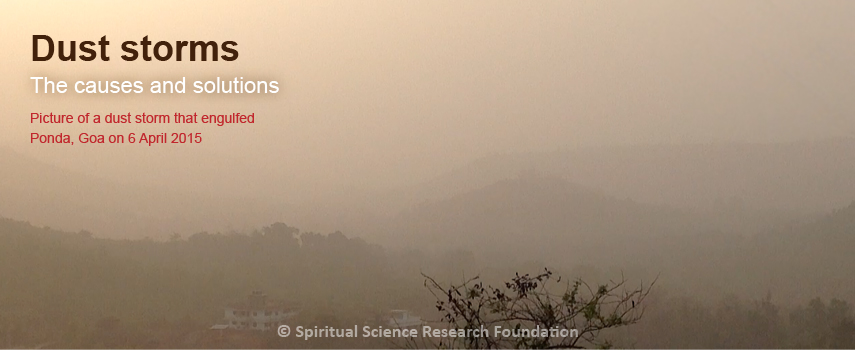Causes of Dust storms
On 2 April 2015, a dust storm in the Arabian Peninsula created headlines. Dust storms are common in this part of the world, but this particular one was unusually severe. Dubai in the United Arab Emirates was one of the cities that was severely affected by this dust storm. Just a few days later on 5th and 6th April 2015 that very dust storm was carried over the Indian Ocean by westerly winds and affected the Indian states of Maharashtra, Gujarat and Goa. The United States Embassy and Consulates’ Air Quality Monitor, which studies the city’s air every day, said Mumbai (in Maharashtra) fell under the ‘very unhealthy’ category on Sunday 5 April 2015.
“What happened for the past three decades is that the frequency and the intensity of dust storms has increased,” says Dr Saad Mohalfi, Saudi Arabia’s permanent representative to the World Meteorological Organisation (WMO). Scientists believe that mankind is partly to blame, for this increase and are worried about the rising frequency of dust storms and the impact it will have on future generations. Dr Iyad Abumoghli, director and regional representative of West Asia at the United Nations Environment Programme (UNEP), said it was important to recognise that while causes for the increase needs to be studied in detail, at least part of the increase was due to human activities.
National Geographic warns that such dust storms can be harmful as they can carry within them various pollen, bacteria, smoke, ash, salt crystals from the ocean, and small bits of dirt or rock, including sand. It can also contain tiny fragments of human and animal skin cells, pollution, and hair. At the Spiritual Research Centre and Ashram in Goa, we were directly influenced by the dust storm from and experienced it first-hand, albeit to a lesser degree than Dubai.
Spiritual research conducted into the causes of dust storms shows that scientists are closer to the truth when they say that humans have an effect on the environment and are responsible for creating such types of natural disasters.
There is a Sanskrit saying that, “If the king is unrighteous, then the subjects too behave in an unrighteous way. Since both do not follow Dharma (Righteousness), several types of dangers can befall their nation,
- Calamities such as floods and famine,
- Diseases and attacks by insects,
- Diseases and attacks by birds and animals,
- Social unrest and infighting within the nation, and
- Attacks from enemies outside the nation.”
When the spiritually impure Raja and Tama subtle basic components increase in people due to unrighteous behaviour, it directly affects the Raja and Tama in the geographical area that they live in. This increase in Raja and Tama gives more strength to negative energies and demonic forces and gives them an impetus to harm society. In the case of dust storms, negative energies take advantage of this added strength to pollute the Absolute Air Principle (Vāyutattva) together with the Absolute Earth Principle (Pruthvītattva) and affect society. If an average person throws dust at someone, it does not have much of an impact. However in the case of a dust storm that is especially charged with distressing vibrations by negative energies, then over and above the physical pollution, it can have severe spiritually adverse effects in the area that it spreads across. In this case, a dust storm that was created by negative energies in the Arabian Peninsula also affected India many thousands of miles away. The following table lists the increase in Raja-Tama in various affected regions in relation to the dust storm that started in the Arabian Peninsula on 2 Apr 2015.
| Region | Increase in Raja-Tama (%) | Duration |
|---|---|---|
| Dubai, UAE | 5 | More |
| Mumbai, India | 5 | Less |
| Goa, India | 5 | Less |
| Spiritual Research Centre and Ashram in Goa, India | 41 | Less |
Source: Spiritual Research
Note 1: Due to the higher level of Divine consciousness (Chaitanya) prevalent at the Spiritual Research Centre and Ashram, it was less affected at a spiritual level from the dust storm. Even so seekers at the Spiritual Research Centre and Ashram experienced various types of distress such as chest pain, nausea, choking sensation, breathlessness, lack of enthusiasm and lethargy during the period of the dust storm. The cause of such distress can be physical and or spiritual due to the dust storm. However in enclosed rooms within the Ashram where seekers were not directly breathing in the outside air, seekers felt better and were less affected.
So what is the solution to this predicament? The answer is simple – people need to lead spiritually purer lifestyles and adhere to the codes of Righteousness (Dharma). The only way for a person to bring about a permanent change for the better in their character and behaviour is to do spiritual practice. The spiritual practice needs to be in accordance with the 6 basic principles of spiritual practice for it to be effective. Unfortunately in the current state of the world, it is improbable that society at large will take up spiritual practice. So it means that large scale natural disasters will continue. Even so seekers who take up spiritual practice can at least defend themselves against increases in spiritual pollution caused by mankind and not be taken advantage of by negative energies. Do read our article on climate change, which looks into the real reasons behind the weird weathers changes taking place around the world.
Blog Post: Sean Clarke
7 April 2015

Recent Comments